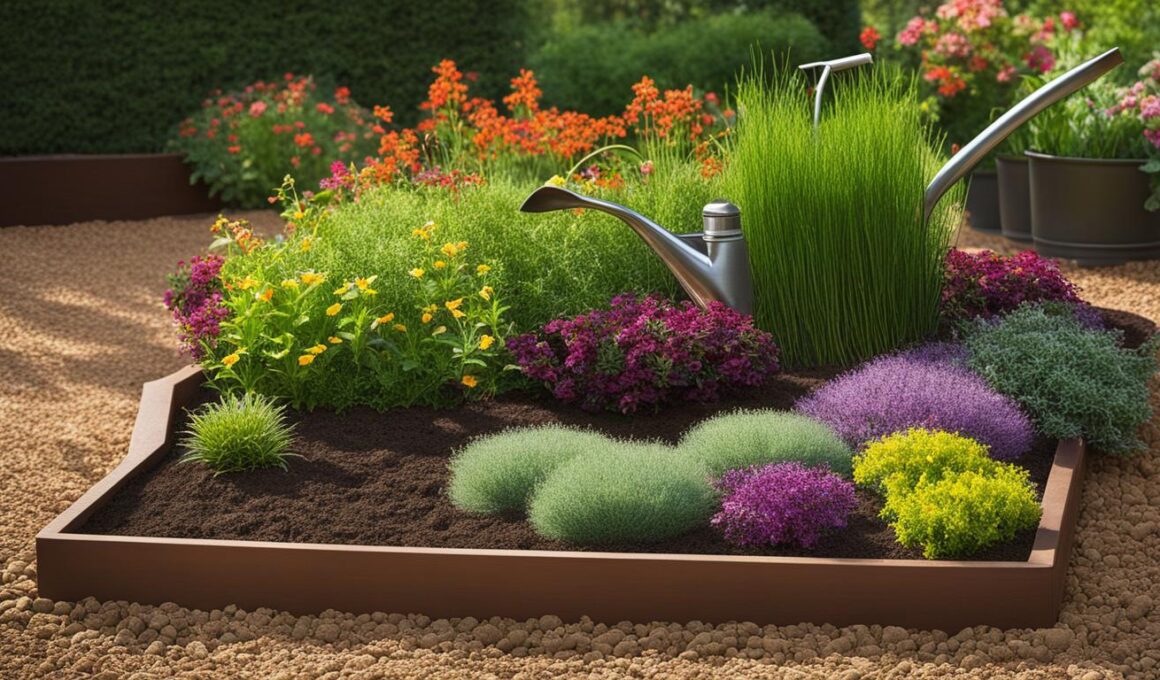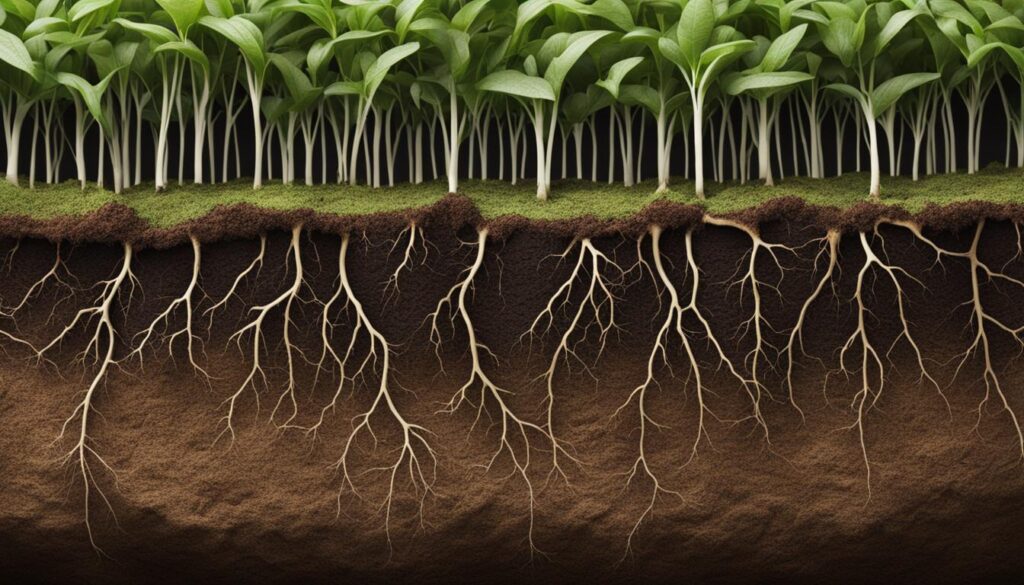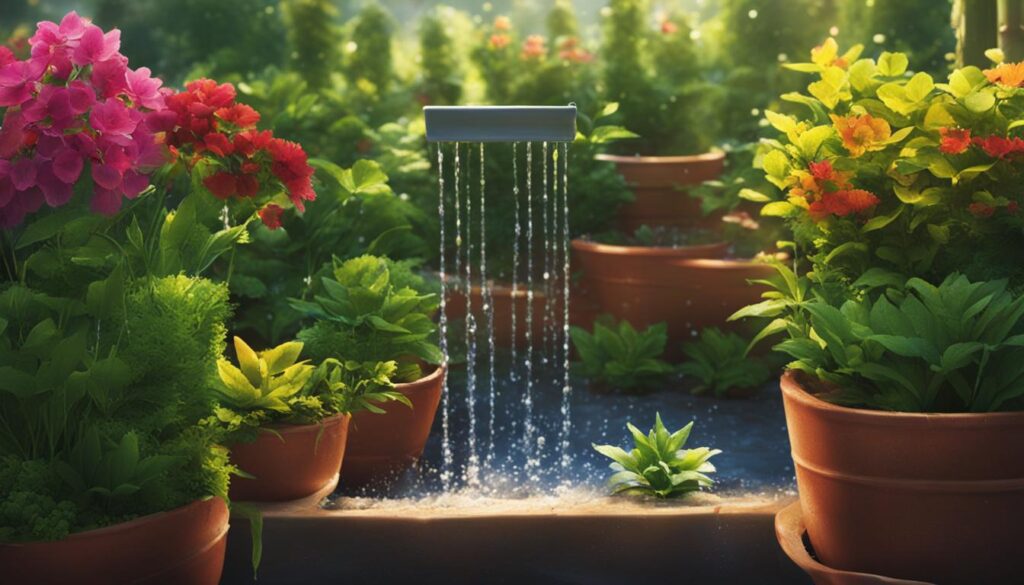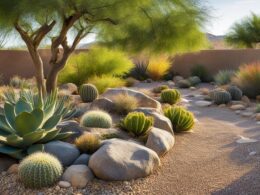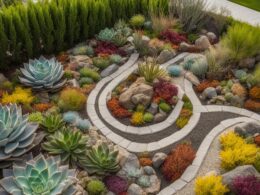Xeriscaping is a gardening technique that focuses on minimizing water usage while creating a beautiful and water-friendly landscape. By selecting and grouping plants appropriately, improving soil quality, using mulch, and implementing efficient watering techniques, you can improve soil water retention and enhance your garden’s resilience to dry conditions. Implementing these strategies will not only conserve water but also create a vibrant and sustainable garden.
Key Takeaways:
- Implement xeriscaping techniques to minimize water usage in your garden.
- Select and group plants with similar water needs to improve water efficiency.
- Improve soil quality by incorporating compost or Miracle-Gro® Moisture Control® Garden Soil.
- Add a layer of mulch, such as Scotts® Nature Scapes® Advanced, to conserve soil moisture.
- Utilize efficient irrigation methods like drip irrigation or soaker hoses.
Select and Group Plants Appropriately for Improved Water Efficiency
One of the key strategies for improving water efficiency in your garden is selecting and grouping plants appropriately. By choosing plants that have similar light, water, and soil requirements, you can ensure that they thrive in their designated areas and minimize water waste. Grouping plants with similar needs also makes it easier to implement targeted watering techniques, ensuring that each plant receives the right amount of water without overwatering or underwatering.
When selecting plants, prioritize drought-tolerant varieties that can withstand dry conditions and require less water. These plants have natural adaptations that allow them to survive with minimal moisture, making them ideal choices for water-efficient landscapes. Consider incorporating native plants and succulents into your garden, as they are well-suited to arid climates and have low water requirements.
In addition to selecting the right plants, it’s important to group them strategically. By grouping plants with similar water needs together, you can create microclimates within your garden that optimize water usage. Planting water-loving plants together in a dedicated area, for example, allows you to provide them with more moisture without wasting water on plants that prefer drier conditions. Similarly, grouping drought-tolerant plants together ensures that they receive the appropriate amount of water without being overwatered.
Table: Examples of Drought-Tolerant Plants
| Plant Name | Water Requirements | Light Requirements | Soil Type |
|---|---|---|---|
| Agave | Low | Full sun | Well-draining |
| Lavender | Low | Full sun | Well-draining |
| Sedum | Low | Full sun to partial shade | Well-draining |
| Yarrow | Low to moderate | Full sun to light shade | Well-draining |
By selecting and grouping plants appropriately, you can maximize water efficiency in your garden and create a thriving, sustainable landscape. Remember to consider the specific water, light, and soil requirements of each plant and utilize this information to create cohesive plant groupings within your garden. Implementing these practices will not only conserve water but also ensure that your plants receive optimal care and thrive in their designated areas.
Improve the Soil for Better Water Retention
To enhance your garden’s resilience to dry conditions and improve soil water retention, it is crucial to focus on improving the quality of your soil. By implementing strategies to increase water retention, you can create an environment that supports healthy plant growth while minimizing water waste.
Amending the Soil
Incorporating organic matter into your soil, such as compost or Miracle-Gro® Moisture Control® Garden Soil, can significantly improve its ability to retain water. These amendments help the soil hold moisture and nutrients, providing a consistent source of hydration for your plants. Adding these organic materials also improves the structure of the soil, allowing it to drain excess water effectively while retaining enough for plant roots to access.
Enhancing Soil Structure
A well-structured soil with good drainage is essential for optimal water retention. If your soil tends to be compacted, consider using a garden fork or tiller to loosen it. This process allows water to penetrate deeper into the soil profile, reducing runoff and increasing the amount of moisture available to plants. By improving soil structure, you create an environment where water is more effectively distributed and retained.
| Soil Amendment | Benefits |
|---|---|
| Compost | Increases water retention, improves soil structure, and provides essential nutrients. |
| Miracle-Gro® Moisture Control® Garden Soil | Enhances moisture retention by up to 25%, improves soil quality, and promotes healthy plant growth. |
By improving soil water retention, you create an environment that supports healthy plant growth and reduces water waste.
Improving soil water retention is a key component of creating a resilient and water-efficient garden. By amending the soil with organic matter and enhancing its structure, you can ensure that your plants have access to the moisture they need while conserving water. Implement these strategies in your garden to promote optimal plant growth and sustainability.
Add Mulch to Conserve Soil Moisture
One effective way to conserve soil moisture in your garden is by adding mulch. Mulch is a protective layer of material that covers the soil surface, helping to regulate temperature, suppress weed growth, and retain moisture. By preventing water evaporation from the soil, mulch plays a crucial role in water conservation.
When choosing mulch for your garden, opt for a high-quality option like Scotts® Nature Scapes® Advanced. This premium mulch is made from natural, color-enhanced wood fibers that not only provide excellent moisture retention but also add aesthetic appeal to your garden. Applying a 3-inch layer of mulch around your plants helps to conserve soil moisture and reduce the need for frequent watering.
Additionally, mulch helps to keep plant roots cooler, which reduces water stress and promotes healthier, more resilient plants. By creating a barrier between the soil and the hot sun, mulch helps to maintain a more even soil temperature, preventing excessive heat from damaging plant roots.
“Mulch acts like a blanket for your soil, keeping it cool and protected from the drying effects of the sun. It’s one of the best and simplest ways to conserve soil moisture in your garden.” – Gardening expert
In addition to conserving soil moisture, mulch also helps to suppress weed growth. By blocking sunlight from reaching weed seeds, mulch inhibits their germination and growth. This reduces competition between weeds and your garden plants for water, nutrients, and sunlight, allowing your plants to thrive.
To apply mulch, spread it evenly around your plants, leaving a small gap around the plant stems to prevent the risk of pests and diseases. Take care not to pile mulch directly against plant stems, as this can create a moist environment that is conducive to rot and disease development.
| BENEFITS OF MULCH | HOW IT WORKS |
|---|---|
| Conserve soil moisture | Mulch acts as a protective barrier and prevents water evaporation from the soil. |
| Suppress weed growth | Mulch blocks sunlight from reaching weed seeds, inhibiting their germination and growth. |
| Maintain soil temperature | Mulch regulates soil temperature, keeping plant roots cooler and preventing heat stress. |
Use Water Wisely for Efficient Irrigation
When it comes to maintaining a water-efficient garden, using water wisely is key. By implementing efficient irrigation practices, you can minimize water waste and ensure that your plants receive the water they need to thrive. Here are some practical tips to help you make the most of your watering efforts:
1. Opt for Drip Irrigation or Soaker Hoses
Drip irrigation and soaker hoses are highly efficient ways to deliver water directly to the roots of your plants. Unlike overhead sprinklers, which can lose up to 90% of water to evaporation, drip irrigation and soaker hoses minimize water waste by targeting the areas where it is needed most. This method also helps prevent water runoff and allows for deep root penetration, resulting in healthier and more resilient plants.
2. Water Infrequently but Deeply
Instead of watering your garden daily, aim to water infrequently but deeply. This encourages plants to develop deep root systems, making them more resilient to drought conditions. Deep watering also helps conserve water as it reduces the need for frequent watering. Remember to adjust your watering schedule based on weather conditions and the specific water needs of different plants.
3. Water Early in the Morning
Watering your garden early in the morning is the ideal time for efficient irrigation. During this time, temperatures are cooler, reducing water evaporation. Additionally, plants have the opportunity to absorb the water before the heat of the day sets in, maximizing water absorption and minimizing water waste.
“Proper irrigation techniques play a significant role in water conservation and the overall health of your garden. By using drip irrigation, watering infrequently but deeply, and timing your watering for the early morning, you can ensure efficient water usage and promote the resilience of your plants.”
Implementing these water-wise irrigation practices not only helps conserve water but also contributes to the overall sustainability of your garden. By being mindful of your watering habits, you can create a thriving and resilient garden that is less dependent on external water sources.
Recommended Products for Soil Water Retention
To improve soil water retention in your garden, consider using the following recommended products:
- Miracle-Gro® Garden Soil All-Purpose: This product can be mixed with native soil to increase moisture retention. It provides essential nutrients for healthy plant growth while enhancing water retention.
- Miracle-Gro® Water Soluble All Purpose Plant Food: This water-soluble plant food delivers nutrients directly to the roots, promoting robust plant growth and supporting improved soil water retention.
- Miracle-Gro® Shake ‘N Feed All Purpose Plant Food: This plant food slowly releases nutrients over time, nourishing your plants and enhancing their ability to retain water. It is a convenient and effective option for maintaining soil moisture levels.
By utilizing these products, you can create an environment in your garden that fosters healthy plant growth and maximizes soil water retention.
“Using Miracle-Gro® Garden Soil All-Purpose has significantly improved the moisture retention in my garden. My plants are thriving, and I’ve noticed a considerable decrease in water usage. It’s a game-changer!” – Happy Gardener
Table: Comparison of Recommended Products for Soil Water Retention
| Product | Benefits | Application |
|---|---|---|
| Miracle-Gro® Garden Soil All-Purpose | Increases moisture retention, provides essential nutrients | Mix with native soil for better water retention |
| Miracle-Gro® Water Soluble All Purpose Plant Food | Delivers nutrients directly to the roots, promotes robust growth | Dissolve in water and apply to plants as directed |
| Miracle-Gro® Shake ‘N Feed All Purpose Plant Food | Slow-release nutrients for sustained plant nourishment | Apply around the base of plants and water thoroughly |
These recommended products are designed to enhance soil water retention and support the long-term health and resilience of your garden. Incorporating them into your gardening routine can help you achieve a vibrant and water-efficient landscape.
Drought-Tolerant Plants for Water-Efficient Landscapes
Creating a water-efficient landscape is essential, especially in areas prone to drought. By selecting drought-tolerant plants, you can conserve water and still maintain a beautiful and vibrant garden. These plants are naturally adapted to arid conditions and require less water, making them an excellent choice for xeriscaping. Here are some popular drought-tolerant plants to consider for your water-efficient landscape:
Succulents
Succulents are a great addition to any water-efficient landscape. These plants store water in their leaves, stems, or roots, allowing them to survive in dry conditions. Some popular succulents include aloe vera, agave, and sedum. They come in a variety of colors, shapes, and sizes, adding visual interest to your garden.
Ornamental Grasses
Ornamental grasses are not only drought-tolerant but also low-maintenance. They can withstand hot and dry conditions while adding texture and movement to your landscape. Some popular choices include feather grass, maiden grass, and fountain grass. These grasses come in different heights and colors, allowing you to create dynamic and visually appealing garden beds.
Xeric Native Plants
Native plants are well-adapted to your local climate, making them excellent choices for water-efficient landscaping. They have evolved to thrive in your specific region, requiring minimal water once established. Some popular xeric native plants include lavender, yarrow, and penstemon. These plants attract pollinators and provide habitat for local wildlife, enhancing the ecological value of your landscape.
Groundcover Plants
Groundcover plants are an effective way to reduce water loss through evaporation and control weed growth. Some popular drought-tolerant groundcovers include creeping thyme, creeping phlox, and ice plant. These low-growing plants create a lush carpet-like effect, adding visual interest and reducing maintenance in your water-efficient landscape.
| Drought-Tolerant Plant | Characteristics | Recommended Zones |
|---|---|---|
| Aloe Vera | Succulent with medicinal properties | 8-11 |
| Lavender | Fragrant flowers and gray-green foliage | 5-9 |
| Fountain Grass | Ornamental grass with cascading foliage | 5-9 |
| Yarrow | Daisy-like flowers in various colors | 3-9 |
| Creeping Thyme | Fragrant groundcover with tiny flowers | 4-9 |
These are just a few examples of drought-tolerant plants that can thrive in a water-efficient landscape. Remember to consider your local climate, soil conditions, and sun exposure when selecting plants for your garden. By incorporating these plants into your landscape design, you can create a beautiful, sustainable, and water-saving garden.
Practical Tips for Successful Xeriscaping
Implementing practical tips can help you achieve successful xeriscaping. By following these guidelines, you can create a water-efficient and visually appealing garden that thrives even in dry conditions.
Choose Drought-Tolerant Plants
When selecting plants for your xeriscape, opt for those that are naturally adapted to arid conditions and require less water. Native plants and succulents, such as ornamental grasses and cacti, are excellent choices. Grouping plants with similar water needs together will further enhance water efficiency in your landscape.
Utilize Efficient Irrigation Systems
Efficient irrigation is crucial for water conservation in xeriscaping. Drip irrigation and soaker hoses deliver water directly to the plant roots, minimizing water waste. Avoid overhead watering, as it can lose up to 90% of water to evaporation. Water your plants infrequently but deeply to encourage deep root systems that can withstand dry conditions. By watering early in the morning, you can maximize water absorption and reduce evaporation.
Incorporate Hardscaping and Mulching
Integrating hardscaping elements, such as pathways, rocks, and gravel, can add visual interest to your xeriscape while reducing the need for water-intensive vegetation. Mulch plays a critical role in conserving soil moisture. Apply a 3-inch layer of high-quality mulch, like Scotts® Nature Scapes® Advanced, to block weed growth, moderate soil temperature, and retain soil moisture.
| Practical Tips for Successful Xeriscaping | |
|---|---|
| Choose Drought-Tolerant Plants | Utilize Efficient Irrigation Systems |
| Native plants and succulents | Drip irrigation and soaker hoses |
| Grouping plants with similar water needs | Avoiding overhead watering |
| Watering infrequently but deeply | |
| Watering early in the morning | |
| Incorporate Hardscaping and Mulching | |
| Integrate pathways, rocks, and gravel | Apply a 3-inch layer of mulch |
| Use high-quality mulch like Scotts® Nature Scapes® Advanced |
By following these practical tips, you can create a successful xeriscape that not only saves water but also adds beauty and resilience to your garden. Remember to regularly maintain your xeriscape by pruning, weeding, and monitoring watering to ensure its long-term success.
Conclusion
Improving soil water retention through xeriscaping techniques is an effective way to create a sustainable and water-efficient garden. By selecting drought-tolerant plants, improving soil quality, using mulch, and implementing efficient watering methods, you can enhance your garden’s resilience to dry conditions and conserve water.
Embracing the principles of xeriscaping not only benefits the environment but also offers financial savings and increased property value. By reducing water usage and creating a vibrant and resilient garden, you can lower your water bills and contribute to a greener future.
Start implementing these strategies today and enjoy a vibrant and water-efficient garden. With careful plant selection, soil improvement, mulching, and wise watering practices, your garden will thrive even in challenging conditions. Create a beautiful and sustainable landscape that will be the envy of your neighbors while conserving water and supporting a healthier planet.
What techniques can I use to improve soil water retention in my xeriscaped garden?
Utilize organic mulches such as wood chips and straw to help with soil moisture retention xeriscapes. Implementing drip irrigation systems can also be effective in providing water directly to the root zones of plants in a xeriscaped garden, promoting better water conservation and soil health.
FAQ
What is xeriscaping?
Xeriscaping is a gardening technique that focuses on minimizing water usage while creating a beautiful and water-friendly landscape.
How does xeriscaping improve soil water retention?
Xeriscaping improves soil water retention by selecting and grouping plants with similar water needs, improving soil quality, using mulch, and implementing efficient watering techniques.
Why is grouping plants important in xeriscaping?
Grouping plants with similar light, water, and soil requirements together ensures efficient water usage and prevents plant stress.
How can I improve soil water retention in my garden?
You can improve soil water retention by amending the soil with compost or garden soil, incorporating Miracle-Gro® Moisture Control® Garden Soil, and using mulch.
What is the role of mulch in conserving soil moisture?
Mulch helps to block weed growth, moderate soil temperature, and retain soil moisture, preventing evaporation and reducing water stress on plants.
What are efficient irrigation practices for water conservation?
Minimizing overhead watering, utilizing drip irrigation or soaker hoses, watering infrequently but deeply, and watering early in the morning are efficient irrigation practices that conserve water.
What products can I use to improve soil water retention?
Recommended products for soil water retention include Miracle-Gro® Garden Soil All-Purpose, Miracle-Gro® Water Soluble All Purpose Plant Food, and Miracle-Gro® Shake ‘N Feed All Purpose Plant Food.
What are some drought-tolerant plants for water-efficient landscapes?
Drought-tolerant plants such as native plants and succulents, including ornamental grasses and cacti, are excellent choices for xeriscaping.
What are some practical tips for successful xeriscaping?
Practical tips for successful xeriscaping include proper soil preparation, selecting the right plants, using efficient irrigation systems, incorporating hardscaping and mulching elements, and regular maintenance.





